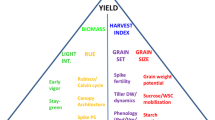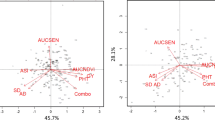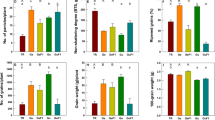Abstract
The physiological and genetic basis of yield improvement in wheat isonly partially understood. Nonetheless, a significant increase in yield andbiomass has been observed in several backgrounds when alien chromatinassociated with Lr19 was introgressed from Agropyronelongatum. Theoretically, higher yield and biomass may be achievedthrough (i) greater interception of incident radiation, (ii) increasedradiation use efficiency, (iii) a more optimal source-sink balance permittinghigher sink demand and/or a higher partitioning of assimilates to yield. Theobjectives of the current study were to evaluate the performance of nearisogenic lines differing in Lr19 to observe the physiological basis ofsuperior performance. Lr19 was associated with increases in yield(average 13%), final biomass (10%) and grain number (15%) in allbackgrounds studied. Differences were not associated with improved lightinterception based on measurements of biomass shortly after canopyclosure, nor with improved radiation use efficiency (RUE) prior to grainfilling based on biomass accumulation rate and direct measurement offlag-leaf photosynthetic rate prior to anthesis. Lr19 was associatedwith an increased partitioning of biomass to spike growth at anthesis(13%), a higher grain number per spike, and higher RUE and flag-leafphotosynthetic rate during grain filling. The mechanism causing increasedpartitioning of assimilates to spikes relative to the rest of the plant in Lr19 isolines was apparently not related to phenology or assimilationcapacity.
Similar content being viewed by others
References
Calderini, D.F., M.P. Reynolds & G.A. Slafer, 1999. Genetic gains in wheat yield and mainphysiological changes associated with them during the 20th century. In: E.H. Satorre & G.A. Slafer (Eds.), Wheat: Ecology and Physiology of Yield Determination. Food Products Press, New York.
Evans, L.T., 1993. Crop Evolution,Adaptation and Yield. Cambridge University Press, Cambridge. 50 pp.
Fischer, R.A., D. Rees, K.D. Sayre, Z.-M. Lu, A.G. Condon & A. Larque-Saavedra, 1998. Wheat yield progress associated with higher stomatal conductance and photosynthetic rate, and cooler canopies. Crop Sci 38: 1467–1475.
Fischer, R.A., 1985. Number of kernelsin wheat crops and the influence of solar radiation and temperature. J Agric Sci 108: 447–461.
Loomis, R.S. & J.S. Amthor, 1999. Yield potential and plant assimilatory capacity and metabolic efficiencies. Crop Sci 39: 1584–1596.
Reynolds, M.P., K.D. Sayre & S. Rajaram, 1999. Physiological and genetic changes of irrigatedwheat in the post green revolution period and approaches for meeting projected global demand. Crop Sci 39: 1611–1621.
Sayre, K.D., S. Rajaram & R.A. Fischer, 1997. Yield potential progress in short bread wheats in northwestMexico. Crop Sci 37: 36–42.
Singh, R.P., J. Huerta-Espino, S. Rajaram & J. Crossa, 1998.Agronomic effects from chromosome translocations 7DL.7Ag and 1BL.1RS in spring wheat. Crop Sci., 38: 27–33.
Slafer, G.A., D.F. Calderini & D.J. Miralles, 1996. Yield components and compensation in wheat: Opportunities forfurther increasing yield potential. In: M.P. Reynolds S. Rajaram & A. McNab (Eds.), Increasing Yield Potential in Wheat: Breaking the Barriers. CIMMYT, Mexico, 101–134.
Slafer, G.A. & R. Savin, 1994. Sink-sourcerelationships and grain mass at different positions within the spike in wheat. Field Crops Res 37: 39–49.
Author information
Authors and Affiliations
Rights and permissions
About this article
Cite this article
Reynolds, M., Calderini, D., Condon, A. et al. Physiological basis of yield gains in wheat associated with the LR19 translocation from Agropyron elongatum . Euphytica 119, 139–144 (2001). https://doi.org/10.1023/A:1017521800795
Issue Date:
DOI: https://doi.org/10.1023/A:1017521800795




